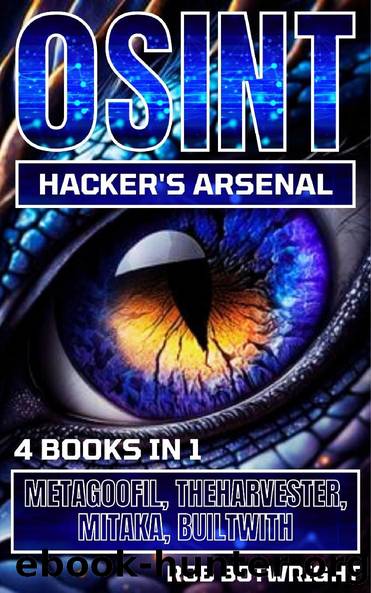OSINT HACKER'S ARSENAL by ROB BOTWRIGHT

Author:ROB BOTWRIGHT [BOTWRIGHT, ROB]
Language: eng
Format: epub
Published: 0101-01-01T00:00:00+00:00
Chapter 10: Mitaka Best Practices and Case Studies
Best practices for Mitaka users are essential to ensure efficient, secure, and productive open-source intelligence (OSINT) operations.
As Mitaka is a powerful tool with numerous capabilities, following these best practices can maximize its potential.
First and foremost, users should start by thoroughly understanding the specific needs and objectives of their OSINT operations.
A clear understanding of what information needs to be collected and analyzed is crucial to making the most of Mitaka's capabilities.
Users should also take the time to explore Mitaka's extensive documentation and resources.
This includes user manuals, tutorials, and community forums, which can provide valuable insights and tips for using the tool effectively.
Before using Mitaka for OSINT, users should ensure that they have the necessary permissions and legal rights to collect and analyze the data they require.
Compliance with data privacy laws and ethical guidelines is paramount.
Users should always respect individuals' privacy and avoid engaging in any activities that could violate legal or ethical standards.
To get started with Mitaka, users should set up their OSINT environment properly.
This includes configuring the tool, installing necessary plugins or modules, and ensuring that all dependencies are met.
A well-configured environment lays the foundation for successful OSINT operations.
It's also essential to keep Mitaka and its associated tools up to date.
Frequent updates may include bug fixes, security patches, and new features that can enhance the tool's performance and security.
Users should regularly check for updates and apply them as needed.
When using Mitaka, it's important to have a clear workflow in place.
A defined workflow helps users stay organized and ensures that all necessary steps are taken during the OSINT process.
Workflow design should consider data collection, analysis, visualization, and reporting.
Automation is one of Mitaka's strengths, and users should leverage it to streamline repetitive tasks.
Creating automated workflows for data collection, analysis, and reporting can save time and increase efficiency.
Mitaka offers a wide range of pre-built modules and integrations, but users should also consider developing custom modules when necessary.
Custom modules can be tailored to specific OSINT needs and provide more comprehensive results.
While custom modules require additional effort to develop, they can significantly enhance the depth and accuracy of OSINT operations.
Users should also be mindful of data quality.
Mitaka provides tools for data preprocessing, cleansing, and normalization.
Cleaning and preparing data before analysis ensures that the results are accurate and reliable.
In OSINT, data can come from various sources, such as websites, social media, and online forums.
Users should be proficient in data collection techniques for different sources and understand the limitations and challenges associated with each.
Mitaka's support for geospatial data is particularly valuable when conducting OSINT operations with a geographic focus.
Users should make use of geospatial data to analyze and visualize information effectively.
Throughout the OSINT process, users should maintain clear documentation of their activities.
Detailed notes and records of data sources, methodologies, and findings are essential for accountability and reporting.
Documentation also helps ensure consistency and repeatability in OSINT operations.
Mitaka users should always verify the credibility of their sources.
Cross-referencing information from multiple sources helps confirm its accuracy and reduces the risk of relying on unreliable or biased data.
Download
This site does not store any files on its server. We only index and link to content provided by other sites. Please contact the content providers to delete copyright contents if any and email us, we'll remove relevant links or contents immediately.
| Cryptography | Encryption |
| Hacking | Network Security |
| Privacy & Online Safety | Security Certifications |
| Viruses |
Effective Threat Investigation for SOC Analysts by Yahia Mostafa;(7258)
Practical Memory Forensics by Svetlana Ostrovskaya & Oleg Skulkin(6961)
Machine Learning Security Principles by John Paul Mueller(6930)
Attacking and Exploiting Modern Web Applications by Simone Onofri & Donato Onofri(6596)
Operationalizing Threat Intelligence by Kyle Wilhoit & Joseph Opacki(6576)
Solidity Programming Essentials by Ritesh Modi(4440)
Microsoft 365 Security, Compliance, and Identity Administration by Peter Rising(4035)
Operationalizing Threat Intelligence by Joseph Opacki Kyle Wilhoit(3782)
Learn Computer Forensics - Second Edition by William Oettinger(3534)
Future Crimes by Marc Goodman(3492)
Blockchain Basics by Daniel Drescher(3462)
Mastering Azure Security by Mustafa Toroman and Tom Janetscheck(3444)
Mastering Python for Networking and Security by José Manuel Ortega(3433)
Building a Next-Gen SOC with IBM QRadar: Accelerate your security operations and detect cyber threats effectively by Ashish M Kothekar(3431)
Incident Response with Threat Intelligence by Roberto Martínez(3257)
The Code Book by Simon Singh(3045)
Mastering Bitcoin: Programming the Open Blockchain by Andreas M. Antonopoulos(2964)
Mobile App Reverse Engineering by Abhinav Mishra(2944)
From CIA to APT: An Introduction to Cyber Security by Edward G. Amoroso & Matthew E. Amoroso(2843)
